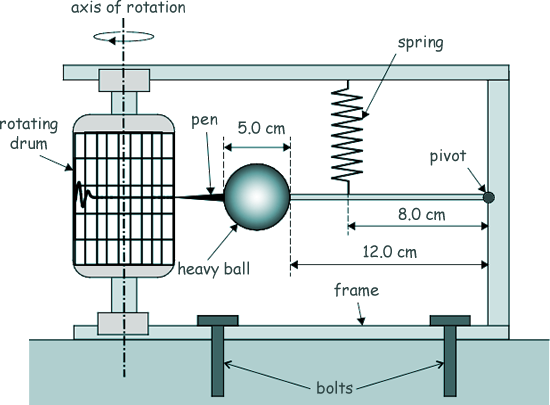SHM - springs Q4. A seismometer is a device that is used to record the movement of the ground during an earthquake. A simple seismometer is shown in the diagram below:
(a) The ball is made of steel of density 8030 kg m–3 and has a diameter of 5.0 cm. Show that the weight of the ball is approximately 5 N. d = 5.0 cm = 5.0 x 10-2 m r = ½ d = 2.5 x 10-2 m Volume of a sphere = 4/3 π r3 V = 4/3 π r3 V = 4/3 π (2.5 x 10-2)3 V = 6.54 x 10-5 m3
density = mass/volume ρ = m/V m = ρV m = 8030 x 6.54 x 10-5 m = 0.53 kg
weight = mass x gravitational field strength w = mg w = 0.53 x 9.81 w = 5.2 N w ≈ 5N Q.E.D.
[3 marks] (b) The distance from the surface of the ball to the pivot is 12.0 cm, as shown in the diagram. Calculate the moment of the weight of the ball about the pivot when the rod is horizontal.
moment = force x perpendicular distance from the pivot point anticlockwise moment = 5.2 N x 0.145 m
[3 marks] (c) The spring is attached at a distance of 8.0 cm from the pivot, and the spring has a stiffness of 100 N m–1. Calculate the extension of the spring when the rod is horizontal and the spring is vertical. You may assume the mass of the pen and the mass of the rod are negligible. To find the force acting on the spring Taking moments about the pivot: clockwise moment from spring = anticlockwise moment from ball F x 0.080 = 0.75 F = 9.4 N To find the spring extension: F = k x x = F/k x = 9.4/100 x = 0.094 m [3 marks] (d) Before an earthquake occurs, the line being drawn on the graph paper is horizontal. Explain what happens to the line on the graph paper when an earthquake is detected and the frame of the seismometer accelerates rapidly downwards. The line/pen moves up. The ball is heavy and therefore has a lot of inertia. Therefore the downwards acceleration of the ball is much less than that of the frame and the ball does not move very far in the time taken for the frame (and the recotating drum) to move down. [2 marks] (Total 11 marks) |
Follow me...
|






